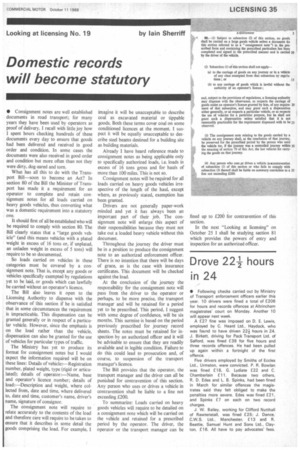Domestic records will become statutory
Page 37

If you've noticed an error in this article please click here to report it so we can fix it.
• Consignment notes are well established documents in road transport; for many years they have been used by operators as proof of delivery. I recall with little joy how I spent hours checking hundreds of these documents every day to ensure that goods had been delivered and received in good order and condition. In some cases the documents were also received in good order and condition but more often than not they were dirty, dog-eared and torn.
What has all this to do with the Transport Bill—soon to become an Act? In section 80 of the Bill the Minister of Transport has made it a requirement for an operator to complete and retain consignment notes for all loads carried on heavy goods vehicles, thus converting what was a domestic requirement into a statutory one.
It should first of all be established who will be required to comply with section 80. The Bill clearly states that a "large goods vehicle" (and this means vehicles with a plated weight in excess of 16 tons or, if unplated, an unladen weight in excess of 5 tons) will require to be so documented.
So loads carried on vehicles in these categories must be covered by a consignment note. That is, except any goods or vehicles specifically exempted by regulations yet to be laid, or goods which can lawfully be carried without an operator's licence.
The Bill also leaves it open to the Licensing Authority to dispense with the observance of this section if he is satisfied that in some circumstances the requirement is impracticable. This dispensation can be granted generally or in respect of a particular vehicle. However, since the emphasis is on the load rather than the vehicle, dispensation can also be granted for the use of vehicles for particular types of traffic.
The Ministry has yet to produce its format for consignment notes but I would expect the information required will be on these lines: Details of vehicle:—Registration number, plated weight, type (rigid or articulated); details of operator:—Name, base and operator's licence number; details of load:—Description and weight. where collected from, date and time, where delivered to, date and time, customer's name, driver's name, signature of consignor.
The consignment note will require to relate accurately to the contents of the load and therefore care will require to be taken to ensure that it describes in some detail the goods comprising the load. For example, I imagine it will be unacceptable to describe coal as excavated material or tippable goods. Both these terms cover coal on some conditioned licences at the moment. I suspect it will be equally unacceptable to describe steel beams destined for a building site as building materials.
Already I have heard reference made to consignment notes as being applicable only to specifically authorized loads, i.e. loads in excess of 16 tons gross and for hauls of more than 100 miles. This is not so.
Consignment notes will be required for all loads carried on heavy goods vehicles irrespective of the length of the haul, except where, as previously stated, exemption has been granted.
Drivers are not generally paper-work minded and yet it has always been an important part of their job. The consignment note will enlarge this aspect of their responsibilities because they must not take out a loaded heavy vehicle without this document.
Throughout the journey the driver must be in a position to produce the consignment note to an authorized enforcement officer. There is no intention that there will be days of grace, as is the case with insurance certificates. This document will be checked against the load.
At the conclusion of the journey the responsibility for the consignment note will pass from the driver to the operator or perhaps, to be more precise, the transport manager and will be retained for a period yet to be prescribed. This period, I suggest with some degree of confidence, will be six months. This surmise is based on the period previously prescribed for journey record sheets. The notes must be retained for inspection by an authorized officer and it will be advisable to ensure that they are readily available and in legible condition. Failure to do this could lead to prosecution and, of course, to suspension of the transport manager's licence.
The Bill provides that the operator, the transport manager and the driver can all be punished for contravention of this section. Any person who uses or drives a vehicle in contravention shall be liable to a fine not exceeding £200.
To summarize: Loads carried on heavy goods vehicles will require to be detailed on a consignment note which will be carried on the vehicle and retained for a prescribed period by the operator. The driver, the operator or the transport manager can be fined up to £200 for contravention of this section.
In the next "Looking at licensing" on October 25 I shall be studying section 81 which provides the powers of entry and inspection for an authorized officer.












































































































